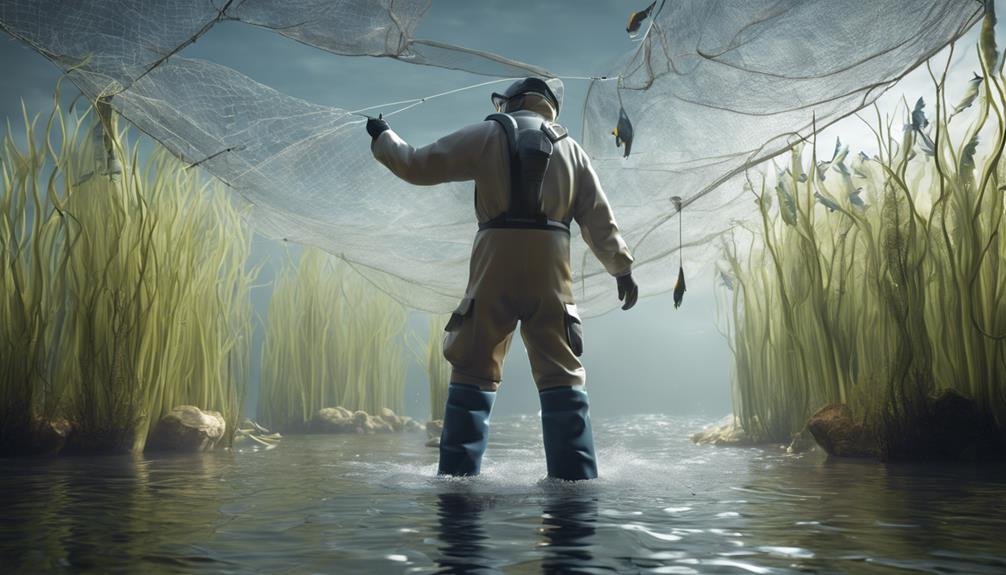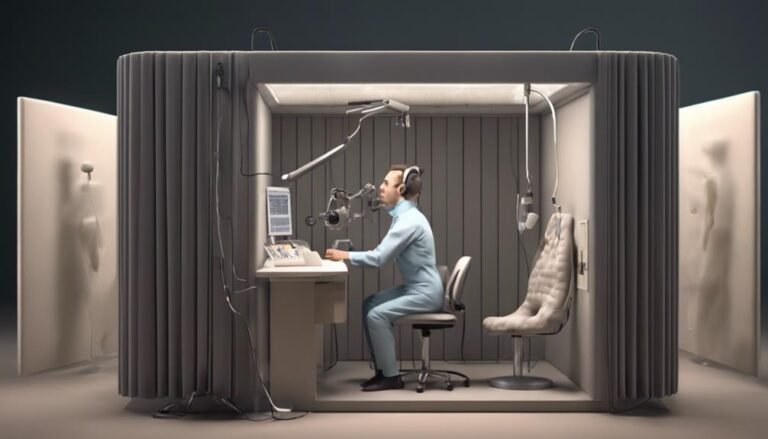Fisheries Biologist Job Description
Fisheries Biologists conduct fish population surveys, monitor water quality, and assess aquatic habitats. They collect samples, implement habitat restoration, and analyze data using statistical tools. Education in Biology and fieldwork experience are essential. Biologists use fieldwork techniques like electrofishing and gill netting for habitat assessments. They collaborate with stakeholders, engage in habitat restoration, and focus on sustainable ecosystem management. Career opportunities include aquaculture, management roles, and research grants. Their work involves conservation initiatives and research publication. This role plays an essential part in maintaining the health and balance of fish populations and aquatic ecosystems.
Key Takeaways
- Conduct surveys to assess fish populations and monitor water quality parameters.
- Collect samples for analysis and implement habitat restoration projects.
- Specialize in fisheries management, aquatic biology, or marine conservation.
- Utilize tools like sonar systems and underwater cameras for data collection.
- Collaborate with stakeholders, experts, and government agencies for effective fisheries management.
Responsibilities
The responsibilities of a fisheries biologist encompass a wide range of tasks related to the study, management, and conservation of aquatic ecosystems. Fieldwork responsibilities play an important role in the daily tasks of a fisheries biologist. These include conducting surveys to assess fish populations, monitoring water quality parameters, and evaluating the health of aquatic habitats. Fieldwork also involves collecting samples for analysis, tagging fish for tracking studies, and implementing habitat restoration projects.
In addition to fieldwork responsibilities, fisheries biologists are deeply involved in developing and implementing habitat preservation strategies. This involves studying the impact of human activities on aquatic ecosystems, identifying threats to fish habitats, and designing conservation plans to mitigate these threats. Habitat preservation strategies may include creating protected areas, restoring riparian zones, and implementing sustainable fishing practices. By integrating fieldwork data with habitat preservation strategies, fisheries biologists play an essential role in ensuring the long-term health and sustainability of aquatic ecosystems.
Education Requirements
To become a fisheries biologist, individuals should pursue a degree in Biology with a focus on specialized fisheries courses. Additionally, fieldwork experience is essential for gaining practical skills and knowledge in the field.
Employers typically seek candidates with a strong educational background and hands-on experience to excel in this profession.
Degree in Biology
A bachelor's degree in biology or a related field is typically required for individuals pursuing a career as a fisheries biologist. This foundational education provides a solid understanding of biological principles, ecology, and environmental science, all of which are essential for success in this field.
A biology degree equips aspiring fisheries biologists with the necessary knowledge to analyze aquatic ecosystems, study fish populations, and contribute to conservation efforts. Additionally, having a strong background in biology opens up various career opportunities within government agencies, research institutions, environmental consulting firms, and non-profit organizations.
With a degree in biology, individuals can specialize in fisheries management, aquatic biology, marine conservation, or other related fields, allowing them to make meaningful contributions to the conservation and sustainable management of aquatic resources.
Specialized Fisheries Courses
Successful pursuit of a career as a fisheries biologist often requires completion of specialized fisheries courses to enhance expertise in aquatic ecosystem management and fish population dynamics. These courses typically cover a range of topics including fieldwork techniques, where students learn to collect data using specialized gear tailored for aquatic environments.
Additionally, students explore fisheries management strategies, understanding how to sustainably utilize and conserve fish populations. Courses in stock assessment are also vital, equipping aspiring fisheries biologists with the skills to evaluate the health and abundance of fish stocks.
Fieldwork Experience Required
Fieldwork experience plays a pivotal role in the education requirements for individuals aspiring to become fisheries biologists. It provides hands-on training essential for understanding aquatic ecosystems and fish populations. Engaging in fieldwork exposes aspiring fisheries biologists to a range of challenges, such as unpredictable weather conditions and rugged terrains.
This practical experience also offers unique research opportunities. It allows individuals to examine fish behavior in their natural habitats, evaluate water quality parameters, and contribute to conservation efforts. Fieldwork provides a platform to apply theoretical knowledge to real-world scenarios, enhancing problem-solving skills and critical thinking abilities.
Additionally, working in the field fosters teamwork and communication skills. Researchers often collaborate on projects and share findings.
Fieldwork Duties
When conducting fieldwork as a fisheries biologist, meticulous data collection and observation techniques are essential for accurately evaluating aquatic ecosystems and fish populations. Fieldwork duties often involve employing a variety of fieldwork techniques and sampling methods to gather information. Fisheries biologists commonly use techniques such as electrofishing, gill netting, and seine netting to capture fish for population assessments. These methods allow biologists to collect data on fish abundance, species composition, and size distribution within a particular water body.
Sampling methods used during fieldwork may include random sampling, stratified sampling, or systematic sampling to guarantee data collected is representative of the entire fish population. In addition to fish collection, fieldwork duties may also involve habitat assessments, water quality testing, and monitoring environmental parameters that can impact fish health and survival. By using precise fieldwork techniques and sampling methods, fisheries biologists can generate accurate data that forms the foundation for informed decision-making in fisheries management and conservation efforts.
Data Collection and Analysis
In the domain of fisheries biology, the careful data collection and observation techniques utilized during fieldwork serve as the foundation for thorough data analysis of aquatic ecosystems and fish populations. Fisheries biologists employ a variety of research methodologies to collect and analyze data, ensuring in-depth insights into the health and dynamics of fish habitats.
Key aspects of data collection and analysis in this field include:
- Use of Advanced Technology: Fisheries biologists utilize cutting-edge tools such as sonar systems and underwater cameras to gather precise data on fish populations and behaviors.
- Sampling Techniques: Employing stratified random sampling methods allows for representative data collection across diverse aquatic environments.
- Statistical Analysis: Data collected during fieldwork is rigorously analyzed using statistical software to derive meaningful patterns and trends.
- Long-Term Monitoring: Continuous data collection over extended periods enables the assessment of ecosystem changes and the impact of human activities on fish populations.
- Interdisciplinary Collaboration: Fisheries biologists often collaborate with experts from other fields such as hydrology and marine biology to enhance the depth and accuracy of data analysis.
Habitat Restoration Projects
Efforts in habitat restoration projects within the fisheries biology domain focus on rejuvenating and enhancing aquatic ecosystems to support sustainable fish populations. Ecosystem restoration plays an essential role in maintaining biodiversity and guaranteeing the long-term health of aquatic habitats. Fisheries biologists engage in a range of activities, including habitat enhancement, wetland restoration, and streambank stabilization to create favorable conditions for fish species. These projects often involve collaboration with various stakeholders, such as government agencies, non-profit organizations, and local communities, emphasizing the importance of community engagement in conservation efforts.
Aquatic habitats serve as vital areas for species conservation, providing essential resources for fish populations to thrive. By restoring degraded habitats, fisheries biologists help improve water quality, create breeding grounds, and enhance overall ecosystem resilience. Through strategic planning and implementation of restoration initiatives, fisheries biologists aim to achieve sustainable fish populations and promote environmental stewardship. The success of habitat restoration projects relies on scientific expertise, innovative technologies, and active participation from the community to guarantee the long-term health of aquatic ecosystems.
Collaboration With Stakeholders
Effective collaboration with stakeholders is essential for fisheries biologists to achieve successful outcomes in their projects.
Stakeholder engagement strategies are carefully developed to guarantee that all parties are involved and informed throughout the process.
Communication channels are utilized to maintain transparency and facilitate meaningful interactions between fisheries biologists and stakeholders.
Stakeholder Engagement Strategies
Several key strategies can be employed to enhance stakeholder engagement in fisheries biology, facilitating collaboration and fostering effective communication channels.
- Establishing Stakeholder Forums: Regular meetings to discuss concerns and share information.
- Utilizing Social Media Platforms: Engaging stakeholders through interactive online platforms.
- Incorporating Community Outreach Programs: Hosting workshops, events, and educational sessions.
- Implementing Public Relations Campaigns: Disseminating accurate information and promoting transparency.
- Encouraging Stakeholder Participation: Involving stakeholders in decision-making processes and project planning.
Communication Channels Utilized
To enhance collaboration with stakeholders, fisheries biologists utilize various communication channels to guarantee effective information exchange and engagement. Stakeholder communication and outreach are crucial aspects of a fisheries biologist's role. These professionals often engage in direct meetings, presentations, and consultations with stakeholders to discuss findings, address concerns, and gather feedback.
Additionally, fisheries biologists leverage social media platforms and networking events to reach a broader audience and disseminate information about conservation efforts, research outcomes, and regulatory updates. By utilizing diverse communication channels, fisheries biologists can foster meaningful relationships with stakeholders, promote transparency in decision-making processes, and make sure that relevant information is shared promptly and thoroughly within the community.
Career Growth Opportunities
Opportunities for career growth in the field of fisheries biology are abundant and diverse, offering professionals a range of paths to advance their expertise and impact within the industry.
- Specialization: Fisheries biologists can specialize in areas such as aquaculture, marine conservation, or fishery management, allowing for in-depth focus and expertise development.
- Management Roles: Advancement to managerial positions like Fisheries Director or Research Team Leader presents opportunities for career advancement and increased influence in decision-making processes.
- Research Opportunities: Pursuing higher education or obtaining research grants can lead to conducting cutting-edge research that contributes significantly to the field.
- International Collaboration: Engaging in international projects or collaborations broadens horizons, facilitates knowledge exchange, and enhances professional networks.
- Policy Development: Involvement in shaping fisheries policies at governmental or organizational levels provides a platform for influencing regulations and promoting sustainable practices.
These avenues not only offer career progression but also open doors for salary negotiations and increased recognition within the fisheries biology domain.
Conservation Initiatives
Building upon the foundation of career growth opportunities in fisheries biology, the implementation of conservation initiatives plays an important role in safeguarding aquatic ecosystems and preserving biodiversity. Fisheries biologists engaged in conservation work focus on the protection and sustainable management of marine ecosystems. Through active participation in policy development, they contribute to the creation of regulations aimed at ensuring the long-term health of fish populations and their habitats. By promoting sustainable practices such as responsible fishing techniques and habitat restoration efforts, fisheries biologists aim to maintain ecological balance and prevent overexploitation of aquatic resources.
In addition to their scientific responsibilities, fisheries biologists often engage in community outreach programs to raise awareness about the importance of conservation. These initiatives involve educating the public about the impact of human activities on marine environments and providing guidance on how individuals can contribute to conservation efforts. By fostering collaboration between scientists, policymakers, and local communities, fisheries biologists play a crucial role in promoting environmental stewardship and biodiversity conservation.
Research and Publication
Engaging in rigorous research endeavors and publishing findings are essential components of the work conducted by fisheries biologists. Research methods utilized by fisheries biologists encompass a wide array of techniques, including underwater surveys, netting, tagging, and genetic analysis. These methods provide vital data on fish populations, habitats, and behaviors, essential for effective conservation and management strategies. Data interpretation is a fundamental aspect of the research process, requiring advanced statistical analyses to draw meaningful conclusions from complex datasets.
- Underwater surveys: Conducted to assess fish population sizes and distribution in their natural habitats.
- Netting: Used to capture fish for study, allowing biologists to gather information on species composition and abundance.
- Tagging: Involves attaching tracking devices to fish to monitor their movements and migration patterns.
- Genetic analysis: Utilized to study the genetic diversity and relatedness among fish populations.
- Statistical analysis: Essential for interpreting research data accurately and making informed decisions regarding fisheries management and conservation efforts.
Conclusion
In summary, the role of a fisheries biologist is essential in the conservation and management of aquatic ecosystems.
Through data collection, analysis, and habitat restoration projects, fisheries biologists play a critical role in ensuring the sustainability of fish populations.
While some may argue that the job can be physically demanding and require long hours in the field, the rewarding opportunity to make a positive impact on the environment and future generations outweighs any challenges faced in this profession.







